Critical Analysis: Key Audit Matters in Independent Auditor's Report
VerifiedAdded on 2023/03/21
|13
|3550
|40
Report
AI Summary
This report critically analyzes key audit matters within the context of independent auditor's reports, focusing on the implications of Auditing Standard ASA 701. It examines the rationale for the standard's introduction, particularly in light of the global financial crisis and the Lehman Brothers' collapse. The analysis includes a review of Westpac Bank's financial statements, emphasizing the accuracy of liabilities related to Australian banknotes and the valuation of foreign currencies and Australian dollar investments. It discusses the auditor's responsibilities, the basis for opinions, and the procedures used to address key audit matters, such as testing key controls and assessing banknote movements. Furthermore, the report evaluates the company's going concern status and other relevant financial information, concluding that the financial statements comply with auditing guidelines set by the AASB.

Key Audit Matters 1
KEY AUDIT MATTERS IN INDEPENDENT AUDITOR’S REPORT
By Student’s Name
Course Code and Name
Professor’s Name
Institution Affiliation
Date
KEY AUDIT MATTERS IN INDEPENDENT AUDITOR’S REPORT
By Student’s Name
Course Code and Name
Professor’s Name
Institution Affiliation
Date
Paraphrase This Document
Need a fresh take? Get an instant paraphrase of this document with our AI Paraphraser
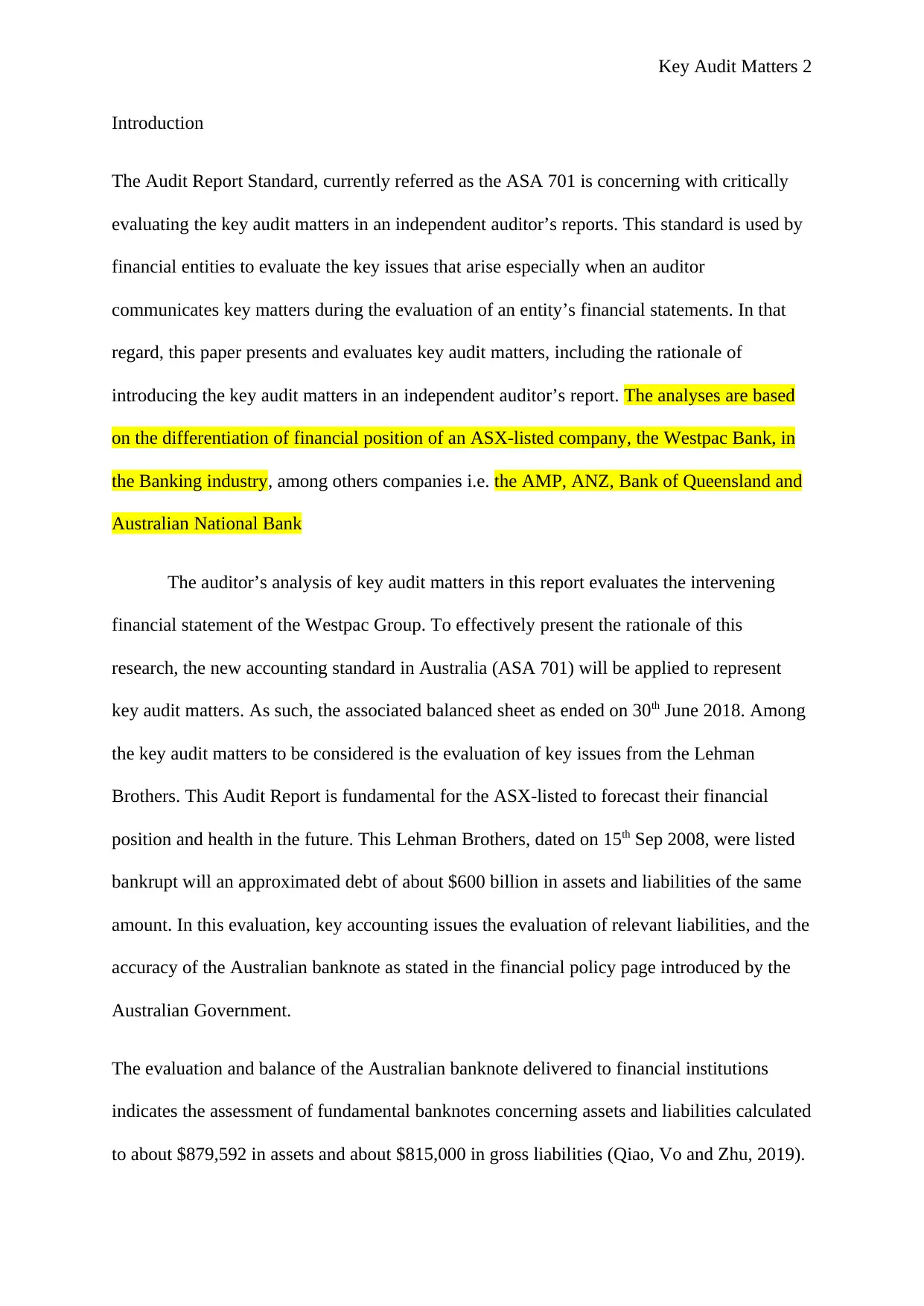
Key Audit Matters 2
Introduction
The Audit Report Standard, currently referred as the ASA 701 is concerning with critically
evaluating the key audit matters in an independent auditor’s reports. This standard is used by
financial entities to evaluate the key issues that arise especially when an auditor
communicates key matters during the evaluation of an entity’s financial statements. In that
regard, this paper presents and evaluates key audit matters, including the rationale of
introducing the key audit matters in an independent auditor’s report. The analyses are based
on the differentiation of financial position of an ASX-listed company, the Westpac Bank, in
the Banking industry, among others companies i.e. the AMP, ANZ, Bank of Queensland and
Australian National Bank
The auditor’s analysis of key audit matters in this report evaluates the intervening
financial statement of the Westpac Group. To effectively present the rationale of this
research, the new accounting standard in Australia (ASA 701) will be applied to represent
key audit matters. As such, the associated balanced sheet as ended on 30th June 2018. Among
the key audit matters to be considered is the evaluation of key issues from the Lehman
Brothers. This Audit Report is fundamental for the ASX-listed to forecast their financial
position and health in the future. This Lehman Brothers, dated on 15th Sep 2008, were listed
bankrupt will an approximated debt of about $600 billion in assets and liabilities of the same
amount. In this evaluation, key accounting issues the evaluation of relevant liabilities, and the
accuracy of the Australian banknote as stated in the financial policy page introduced by the
Australian Government.
The evaluation and balance of the Australian banknote delivered to financial institutions
indicates the assessment of fundamental banknotes concerning assets and liabilities calculated
to about $879,592 in assets and about $815,000 in gross liabilities (Qiao, Vo and Zhu, 2019).
Introduction
The Audit Report Standard, currently referred as the ASA 701 is concerning with critically
evaluating the key audit matters in an independent auditor’s reports. This standard is used by
financial entities to evaluate the key issues that arise especially when an auditor
communicates key matters during the evaluation of an entity’s financial statements. In that
regard, this paper presents and evaluates key audit matters, including the rationale of
introducing the key audit matters in an independent auditor’s report. The analyses are based
on the differentiation of financial position of an ASX-listed company, the Westpac Bank, in
the Banking industry, among others companies i.e. the AMP, ANZ, Bank of Queensland and
Australian National Bank
The auditor’s analysis of key audit matters in this report evaluates the intervening
financial statement of the Westpac Group. To effectively present the rationale of this
research, the new accounting standard in Australia (ASA 701) will be applied to represent
key audit matters. As such, the associated balanced sheet as ended on 30th June 2018. Among
the key audit matters to be considered is the evaluation of key issues from the Lehman
Brothers. This Audit Report is fundamental for the ASX-listed to forecast their financial
position and health in the future. This Lehman Brothers, dated on 15th Sep 2008, were listed
bankrupt will an approximated debt of about $600 billion in assets and liabilities of the same
amount. In this evaluation, key accounting issues the evaluation of relevant liabilities, and the
accuracy of the Australian banknote as stated in the financial policy page introduced by the
Australian Government.
The evaluation and balance of the Australian banknote delivered to financial institutions
indicates the assessment of fundamental banknotes concerning assets and liabilities calculated
to about $879,592 in assets and about $815,000 in gross liabilities (Qiao, Vo and Zhu, 2019).
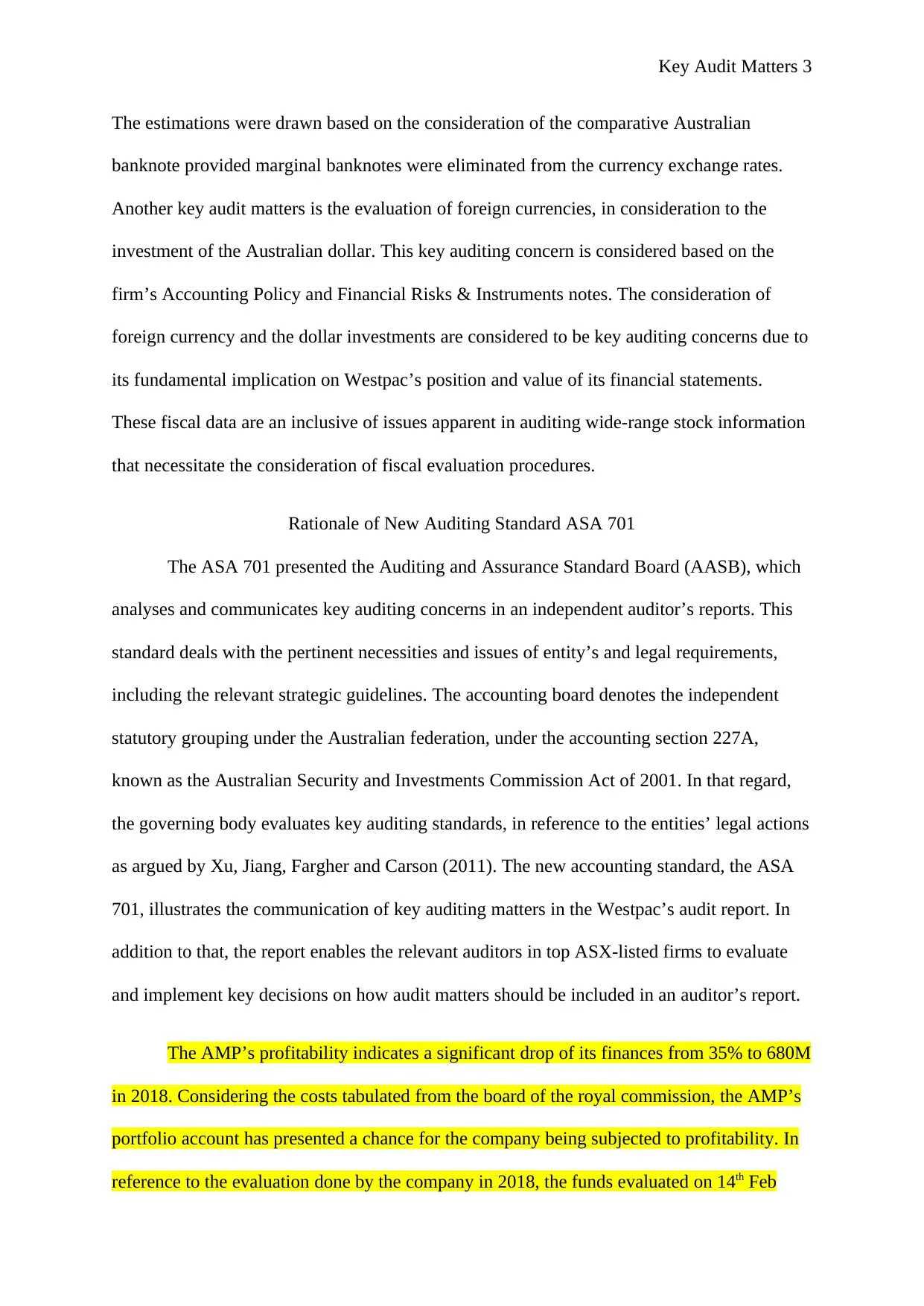
Key Audit Matters 3
The estimations were drawn based on the consideration of the comparative Australian
banknote provided marginal banknotes were eliminated from the currency exchange rates.
Another key audit matters is the evaluation of foreign currencies, in consideration to the
investment of the Australian dollar. This key auditing concern is considered based on the
firm’s Accounting Policy and Financial Risks & Instruments notes. The consideration of
foreign currency and the dollar investments are considered to be key auditing concerns due to
its fundamental implication on Westpac’s position and value of its financial statements.
These fiscal data are an inclusive of issues apparent in auditing wide-range stock information
that necessitate the consideration of fiscal evaluation procedures.
Rationale of New Auditing Standard ASA 701
The ASA 701 presented the Auditing and Assurance Standard Board (AASB), which
analyses and communicates key auditing concerns in an independent auditor’s reports. This
standard deals with the pertinent necessities and issues of entity’s and legal requirements,
including the relevant strategic guidelines. The accounting board denotes the independent
statutory grouping under the Australian federation, under the accounting section 227A,
known as the Australian Security and Investments Commission Act of 2001. In that regard,
the governing body evaluates key auditing standards, in reference to the entities’ legal actions
as argued by Xu, Jiang, Fargher and Carson (2011). The new accounting standard, the ASA
701, illustrates the communication of key auditing matters in the Westpac’s audit report. In
addition to that, the report enables the relevant auditors in top ASX-listed firms to evaluate
and implement key decisions on how audit matters should be included in an auditor’s report.
The AMP’s profitability indicates a significant drop of its finances from 35% to 680M
in 2018. Considering the costs tabulated from the board of the royal commission, the AMP’s
portfolio account has presented a chance for the company being subjected to profitability. In
reference to the evaluation done by the company in 2018, the funds evaluated on 14th Feb
The estimations were drawn based on the consideration of the comparative Australian
banknote provided marginal banknotes were eliminated from the currency exchange rates.
Another key audit matters is the evaluation of foreign currencies, in consideration to the
investment of the Australian dollar. This key auditing concern is considered based on the
firm’s Accounting Policy and Financial Risks & Instruments notes. The consideration of
foreign currency and the dollar investments are considered to be key auditing concerns due to
its fundamental implication on Westpac’s position and value of its financial statements.
These fiscal data are an inclusive of issues apparent in auditing wide-range stock information
that necessitate the consideration of fiscal evaluation procedures.
Rationale of New Auditing Standard ASA 701
The ASA 701 presented the Auditing and Assurance Standard Board (AASB), which
analyses and communicates key auditing concerns in an independent auditor’s reports. This
standard deals with the pertinent necessities and issues of entity’s and legal requirements,
including the relevant strategic guidelines. The accounting board denotes the independent
statutory grouping under the Australian federation, under the accounting section 227A,
known as the Australian Security and Investments Commission Act of 2001. In that regard,
the governing body evaluates key auditing standards, in reference to the entities’ legal actions
as argued by Xu, Jiang, Fargher and Carson (2011). The new accounting standard, the ASA
701, illustrates the communication of key auditing matters in the Westpac’s audit report. In
addition to that, the report enables the relevant auditors in top ASX-listed firms to evaluate
and implement key decisions on how audit matters should be included in an auditor’s report.
The AMP’s profitability indicates a significant drop of its finances from 35% to 680M
in 2018. Considering the costs tabulated from the board of the royal commission, the AMP’s
portfolio account has presented a chance for the company being subjected to profitability. In
reference to the evaluation done by the company in 2018, the funds evaluated on 14th Feb
⊘ This is a preview!⊘
Do you want full access?
Subscribe today to unlock all pages.

Trusted by 1+ million students worldwide
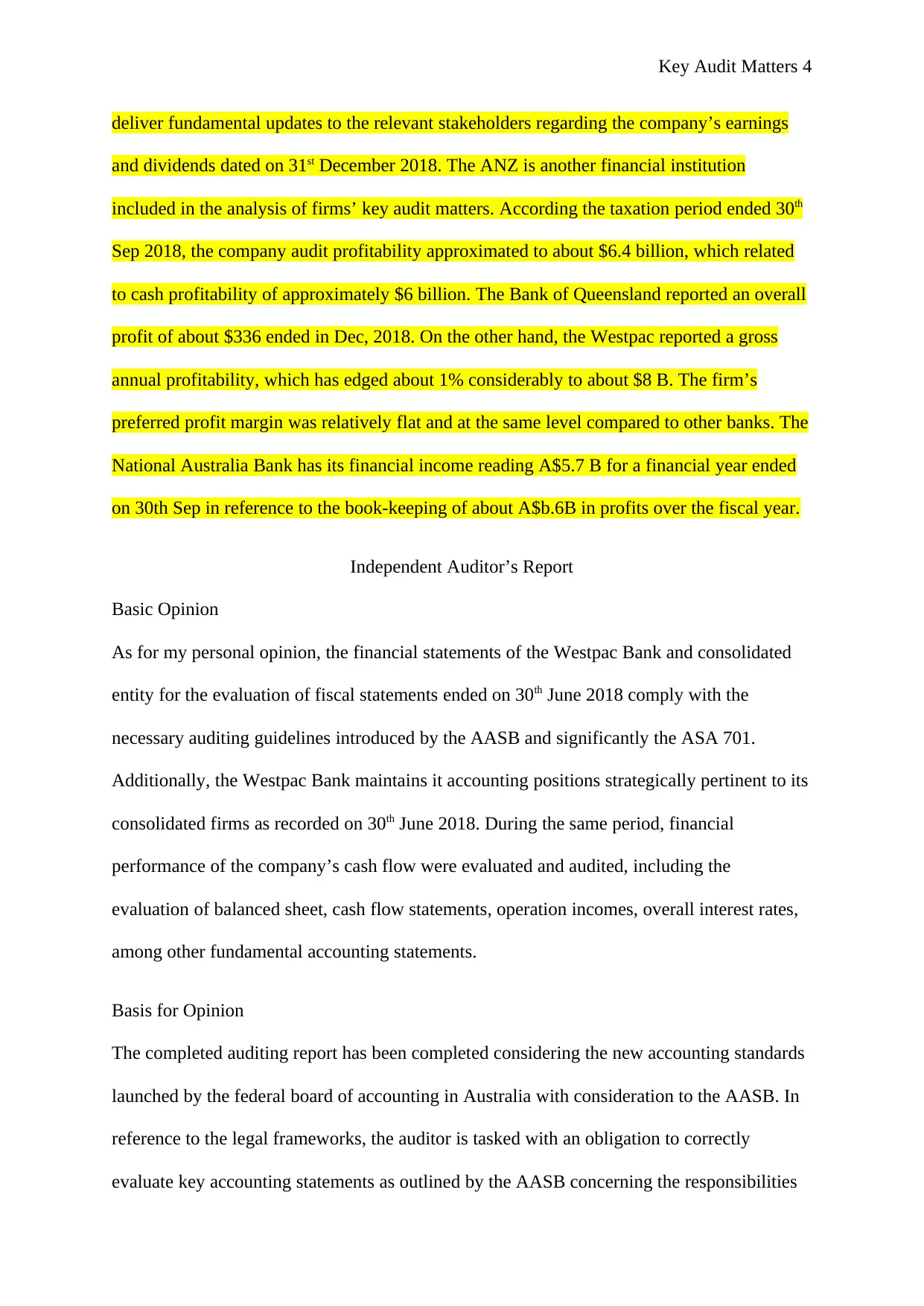
Key Audit Matters 4
deliver fundamental updates to the relevant stakeholders regarding the company’s earnings
and dividends dated on 31st December 2018. The ANZ is another financial institution
included in the analysis of firms’ key audit matters. According the taxation period ended 30th
Sep 2018, the company audit profitability approximated to about $6.4 billion, which related
to cash profitability of approximately $6 billion. The Bank of Queensland reported an overall
profit of about $336 ended in Dec, 2018. On the other hand, the Westpac reported a gross
annual profitability, which has edged about 1% considerably to about $8 B. The firm’s
preferred profit margin was relatively flat and at the same level compared to other banks. The
National Australia Bank has its financial income reading A$5.7 B for a financial year ended
on 30th Sep in reference to the book-keeping of about A$b.6B in profits over the fiscal year.
Independent Auditor’s Report
Basic Opinion
As for my personal opinion, the financial statements of the Westpac Bank and consolidated
entity for the evaluation of fiscal statements ended on 30th June 2018 comply with the
necessary auditing guidelines introduced by the AASB and significantly the ASA 701.
Additionally, the Westpac Bank maintains it accounting positions strategically pertinent to its
consolidated firms as recorded on 30th June 2018. During the same period, financial
performance of the company’s cash flow were evaluated and audited, including the
evaluation of balanced sheet, cash flow statements, operation incomes, overall interest rates,
among other fundamental accounting statements.
Basis for Opinion
The completed auditing report has been completed considering the new accounting standards
launched by the federal board of accounting in Australia with consideration to the AASB. In
reference to the legal frameworks, the auditor is tasked with an obligation to correctly
evaluate key accounting statements as outlined by the AASB concerning the responsibilities
deliver fundamental updates to the relevant stakeholders regarding the company’s earnings
and dividends dated on 31st December 2018. The ANZ is another financial institution
included in the analysis of firms’ key audit matters. According the taxation period ended 30th
Sep 2018, the company audit profitability approximated to about $6.4 billion, which related
to cash profitability of approximately $6 billion. The Bank of Queensland reported an overall
profit of about $336 ended in Dec, 2018. On the other hand, the Westpac reported a gross
annual profitability, which has edged about 1% considerably to about $8 B. The firm’s
preferred profit margin was relatively flat and at the same level compared to other banks. The
National Australia Bank has its financial income reading A$5.7 B for a financial year ended
on 30th Sep in reference to the book-keeping of about A$b.6B in profits over the fiscal year.
Independent Auditor’s Report
Basic Opinion
As for my personal opinion, the financial statements of the Westpac Bank and consolidated
entity for the evaluation of fiscal statements ended on 30th June 2018 comply with the
necessary auditing guidelines introduced by the AASB and significantly the ASA 701.
Additionally, the Westpac Bank maintains it accounting positions strategically pertinent to its
consolidated firms as recorded on 30th June 2018. During the same period, financial
performance of the company’s cash flow were evaluated and audited, including the
evaluation of balanced sheet, cash flow statements, operation incomes, overall interest rates,
among other fundamental accounting statements.
Basis for Opinion
The completed auditing report has been completed considering the new accounting standards
launched by the federal board of accounting in Australia with consideration to the AASB. In
reference to the legal frameworks, the auditor is tasked with an obligation to correctly
evaluate key accounting statements as outlined by the AASB concerning the responsibilities
Paraphrase This Document
Need a fresh take? Get an instant paraphrase of this document with our AI Paraphraser
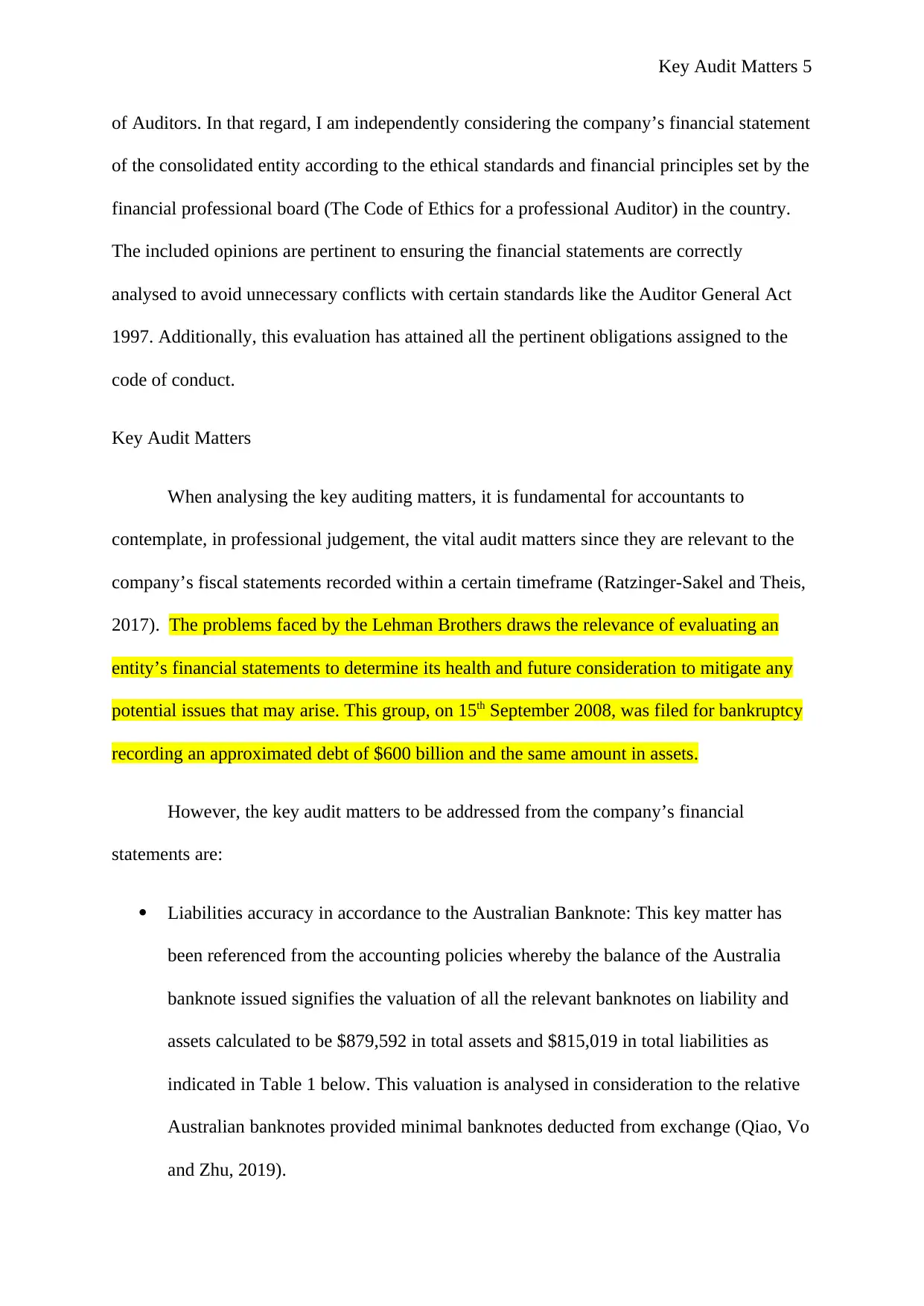
Key Audit Matters 5
of Auditors. In that regard, I am independently considering the company’s financial statement
of the consolidated entity according to the ethical standards and financial principles set by the
financial professional board (The Code of Ethics for a professional Auditor) in the country.
The included opinions are pertinent to ensuring the financial statements are correctly
analysed to avoid unnecessary conflicts with certain standards like the Auditor General Act
1997. Additionally, this evaluation has attained all the pertinent obligations assigned to the
code of conduct.
Key Audit Matters
When analysing the key auditing matters, it is fundamental for accountants to
contemplate, in professional judgement, the vital audit matters since they are relevant to the
company’s fiscal statements recorded within a certain timeframe (Ratzinger-Sakel and Theis,
2017). The problems faced by the Lehman Brothers draws the relevance of evaluating an
entity’s financial statements to determine its health and future consideration to mitigate any
potential issues that may arise. This group, on 15th September 2008, was filed for bankruptcy
recording an approximated debt of $600 billion and the same amount in assets.
However, the key audit matters to be addressed from the company’s financial
statements are:
Liabilities accuracy in accordance to the Australian Banknote: This key matter has
been referenced from the accounting policies whereby the balance of the Australia
banknote issued signifies the valuation of all the relevant banknotes on liability and
assets calculated to be $879,592 in total assets and $815,019 in total liabilities as
indicated in Table 1 below. This valuation is analysed in consideration to the relative
Australian banknotes provided minimal banknotes deducted from exchange (Qiao, Vo
and Zhu, 2019).
of Auditors. In that regard, I am independently considering the company’s financial statement
of the consolidated entity according to the ethical standards and financial principles set by the
financial professional board (The Code of Ethics for a professional Auditor) in the country.
The included opinions are pertinent to ensuring the financial statements are correctly
analysed to avoid unnecessary conflicts with certain standards like the Auditor General Act
1997. Additionally, this evaluation has attained all the pertinent obligations assigned to the
code of conduct.
Key Audit Matters
When analysing the key auditing matters, it is fundamental for accountants to
contemplate, in professional judgement, the vital audit matters since they are relevant to the
company’s fiscal statements recorded within a certain timeframe (Ratzinger-Sakel and Theis,
2017). The problems faced by the Lehman Brothers draws the relevance of evaluating an
entity’s financial statements to determine its health and future consideration to mitigate any
potential issues that may arise. This group, on 15th September 2008, was filed for bankruptcy
recording an approximated debt of $600 billion and the same amount in assets.
However, the key audit matters to be addressed from the company’s financial
statements are:
Liabilities accuracy in accordance to the Australian Banknote: This key matter has
been referenced from the accounting policies whereby the balance of the Australia
banknote issued signifies the valuation of all the relevant banknotes on liability and
assets calculated to be $879,592 in total assets and $815,019 in total liabilities as
indicated in Table 1 below. This valuation is analysed in consideration to the relative
Australian banknotes provided minimal banknotes deducted from exchange (Qiao, Vo
and Zhu, 2019).
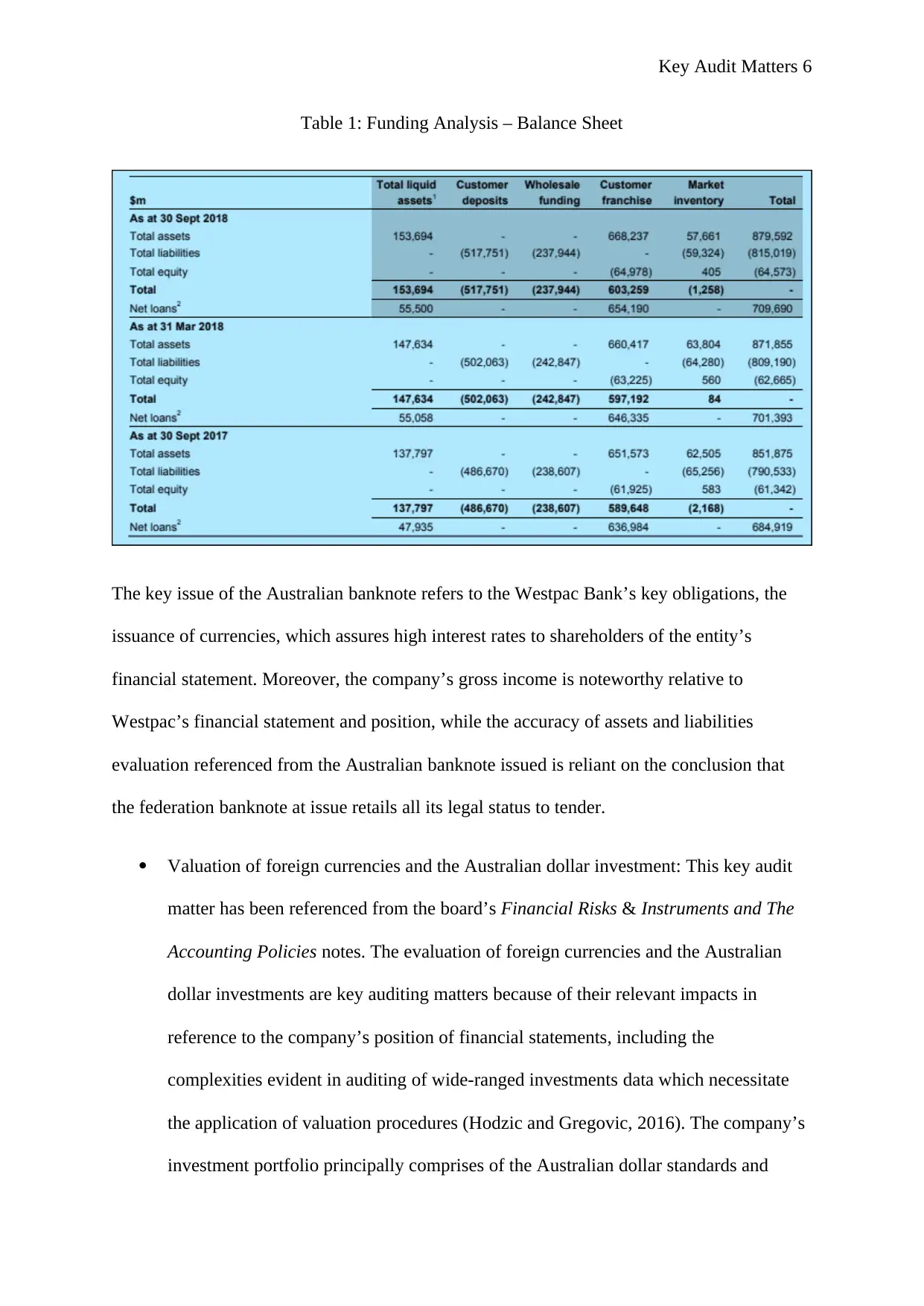
Key Audit Matters 6
Table 1: Funding Analysis – Balance Sheet
The key issue of the Australian banknote refers to the Westpac Bank’s key obligations, the
issuance of currencies, which assures high interest rates to shareholders of the entity’s
financial statement. Moreover, the company’s gross income is noteworthy relative to
Westpac’s financial statement and position, while the accuracy of assets and liabilities
evaluation referenced from the Australian banknote issued is reliant on the conclusion that
the federation banknote at issue retails all its legal status to tender.
Valuation of foreign currencies and the Australian dollar investment: This key audit
matter has been referenced from the board’s Financial Risks & Instruments and The
Accounting Policies notes. The evaluation of foreign currencies and the Australian
dollar investments are key auditing matters because of their relevant impacts in
reference to the company’s position of financial statements, including the
complexities evident in auditing of wide-ranged investments data which necessitate
the application of valuation procedures (Hodzic and Gregovic, 2016). The company’s
investment portfolio principally comprises of the Australian dollar standards and
Table 1: Funding Analysis – Balance Sheet
The key issue of the Australian banknote refers to the Westpac Bank’s key obligations, the
issuance of currencies, which assures high interest rates to shareholders of the entity’s
financial statement. Moreover, the company’s gross income is noteworthy relative to
Westpac’s financial statement and position, while the accuracy of assets and liabilities
evaluation referenced from the Australian banknote issued is reliant on the conclusion that
the federation banknote at issue retails all its legal status to tender.
Valuation of foreign currencies and the Australian dollar investment: This key audit
matter has been referenced from the board’s Financial Risks & Instruments and The
Accounting Policies notes. The evaluation of foreign currencies and the Australian
dollar investments are key auditing matters because of their relevant impacts in
reference to the company’s position of financial statements, including the
complexities evident in auditing of wide-ranged investments data which necessitate
the application of valuation procedures (Hodzic and Gregovic, 2016). The company’s
investment portfolio principally comprises of the Australian dollar standards and
⊘ This is a preview!⊘
Do you want full access?
Subscribe today to unlock all pages.

Trusted by 1+ million students worldwide
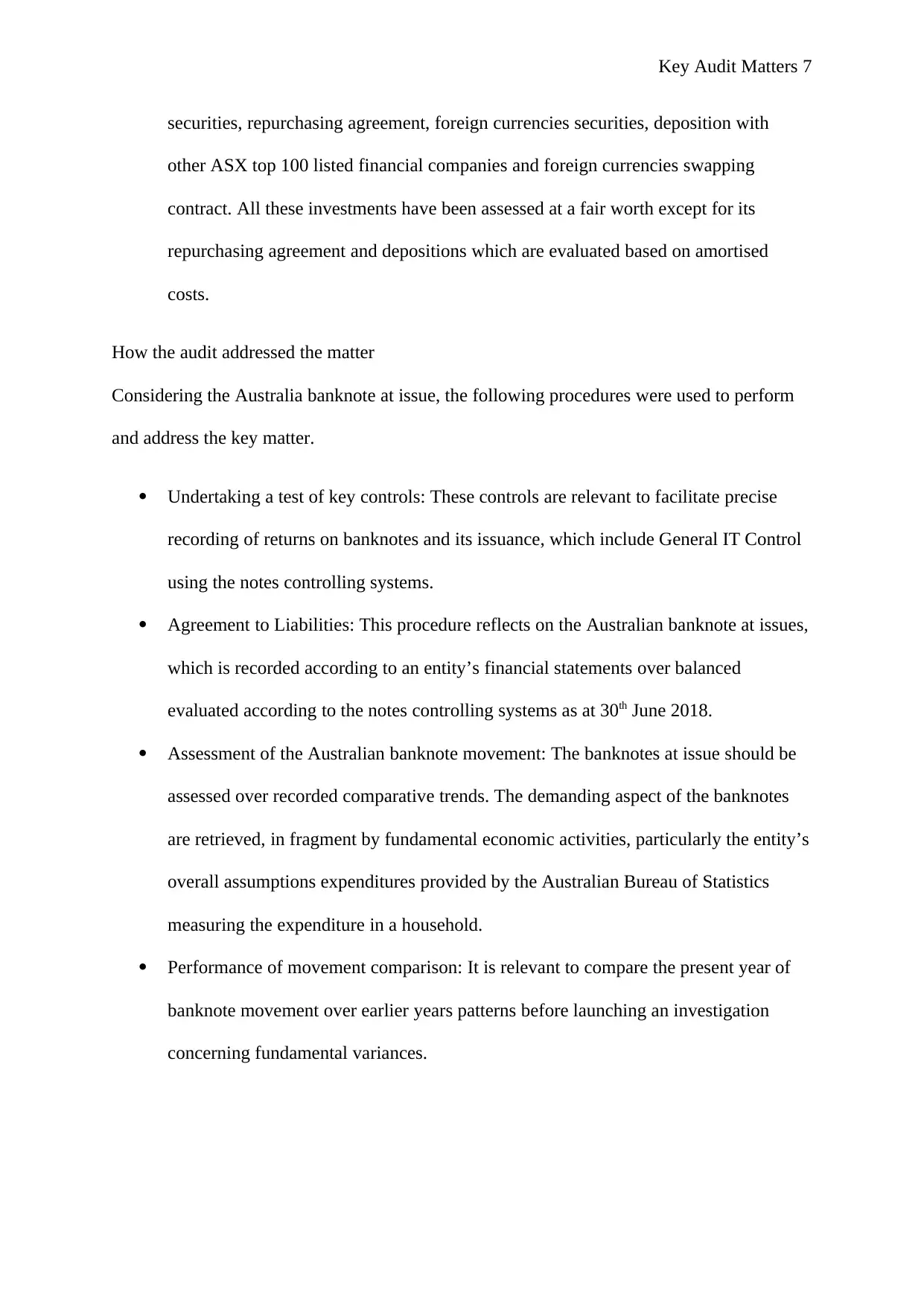
Key Audit Matters 7
securities, repurchasing agreement, foreign currencies securities, deposition with
other ASX top 100 listed financial companies and foreign currencies swapping
contract. All these investments have been assessed at a fair worth except for its
repurchasing agreement and depositions which are evaluated based on amortised
costs.
How the audit addressed the matter
Considering the Australia banknote at issue, the following procedures were used to perform
and address the key matter.
Undertaking a test of key controls: These controls are relevant to facilitate precise
recording of returns on banknotes and its issuance, which include General IT Control
using the notes controlling systems.
Agreement to Liabilities: This procedure reflects on the Australian banknote at issues,
which is recorded according to an entity’s financial statements over balanced
evaluated according to the notes controlling systems as at 30th June 2018.
Assessment of the Australian banknote movement: The banknotes at issue should be
assessed over recorded comparative trends. The demanding aspect of the banknotes
are retrieved, in fragment by fundamental economic activities, particularly the entity’s
overall assumptions expenditures provided by the Australian Bureau of Statistics
measuring the expenditure in a household.
Performance of movement comparison: It is relevant to compare the present year of
banknote movement over earlier years patterns before launching an investigation
concerning fundamental variances.
securities, repurchasing agreement, foreign currencies securities, deposition with
other ASX top 100 listed financial companies and foreign currencies swapping
contract. All these investments have been assessed at a fair worth except for its
repurchasing agreement and depositions which are evaluated based on amortised
costs.
How the audit addressed the matter
Considering the Australia banknote at issue, the following procedures were used to perform
and address the key matter.
Undertaking a test of key controls: These controls are relevant to facilitate precise
recording of returns on banknotes and its issuance, which include General IT Control
using the notes controlling systems.
Agreement to Liabilities: This procedure reflects on the Australian banknote at issues,
which is recorded according to an entity’s financial statements over balanced
evaluated according to the notes controlling systems as at 30th June 2018.
Assessment of the Australian banknote movement: The banknotes at issue should be
assessed over recorded comparative trends. The demanding aspect of the banknotes
are retrieved, in fragment by fundamental economic activities, particularly the entity’s
overall assumptions expenditures provided by the Australian Bureau of Statistics
measuring the expenditure in a household.
Performance of movement comparison: It is relevant to compare the present year of
banknote movement over earlier years patterns before launching an investigation
concerning fundamental variances.
Paraphrase This Document
Need a fresh take? Get an instant paraphrase of this document with our AI Paraphraser

Key Audit Matters 8
Going Concern
The consolidated fiscal statement of the company have been analysed and evaluated
considering the going concern accounting basis.
Table 2: Divisional Cash Incomes Summation
The application of this accounting concern is fundamental unless the company’s management
either considers liquidating the entity or ceasing its business operations, including the
evaluation of whether it has recorded any realistic alternatives to execute these activities or
not. As a fragment of this audit report of in reference to the consolidated fiscal statements, it
can be concluded that the management’s utility of the going concern accounting framework is
appropriately executed in accordance to the group’s consolidated fiscal statements (Ha, Lee
and Park, 2018). The group’s management has not yet identified any material uncertainties
which might present any considerable doubts on the company’s capabilities to proceed as a
going concern. Reflectively, it is minimally disclosed of material uncertainties in the
associated fiscal statements of the entity. Nonetheless, the auditor and the management
cannot assure of the entity’s capabilities to proceed as a going concern.
Going Concern
The consolidated fiscal statement of the company have been analysed and evaluated
considering the going concern accounting basis.
Table 2: Divisional Cash Incomes Summation
The application of this accounting concern is fundamental unless the company’s management
either considers liquidating the entity or ceasing its business operations, including the
evaluation of whether it has recorded any realistic alternatives to execute these activities or
not. As a fragment of this audit report of in reference to the consolidated fiscal statements, it
can be concluded that the management’s utility of the going concern accounting framework is
appropriately executed in accordance to the group’s consolidated fiscal statements (Ha, Lee
and Park, 2018). The group’s management has not yet identified any material uncertainties
which might present any considerable doubts on the company’s capabilities to proceed as a
going concern. Reflectively, it is minimally disclosed of material uncertainties in the
associated fiscal statements of the entity. Nonetheless, the auditor and the management
cannot assure of the entity’s capabilities to proceed as a going concern.
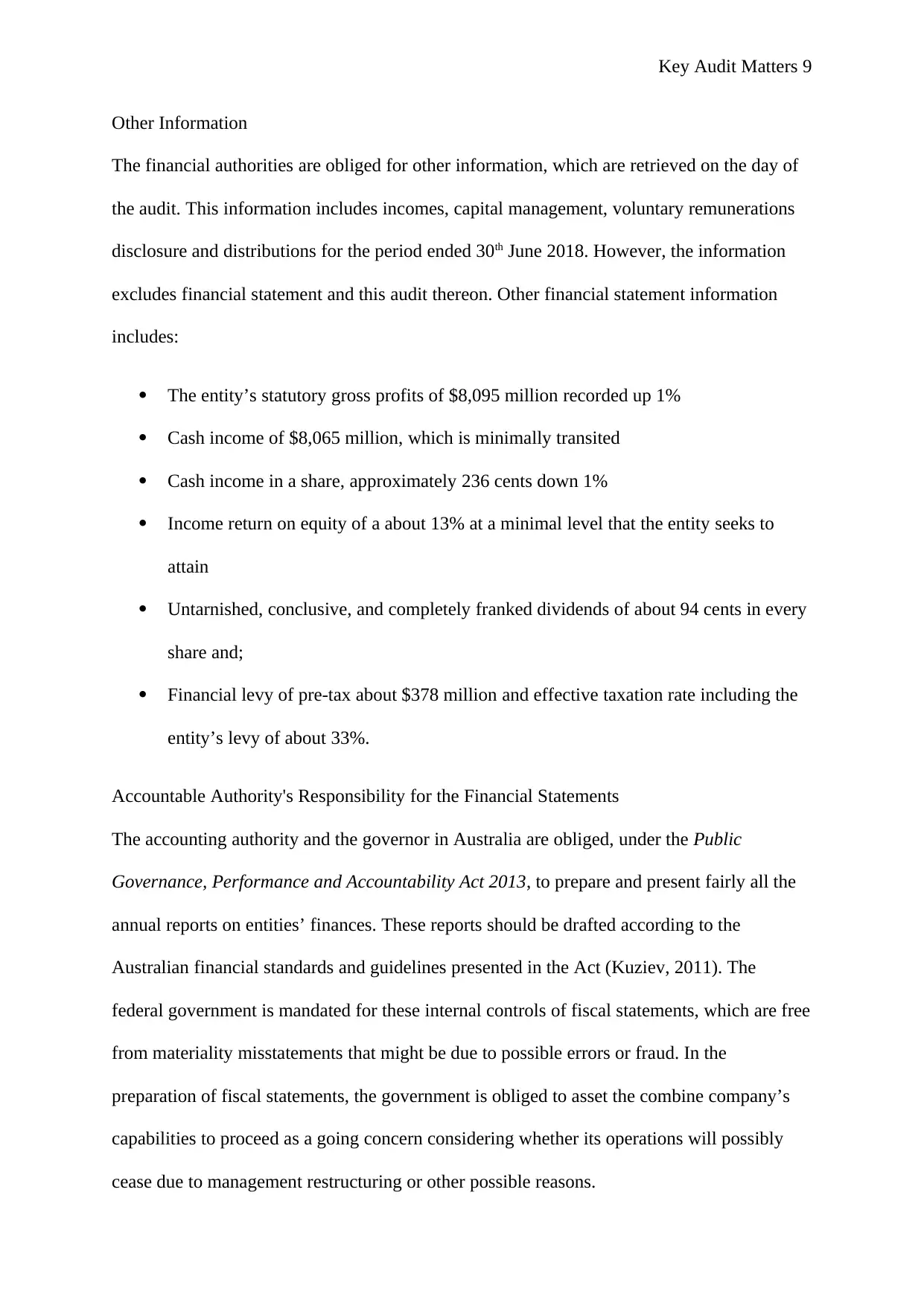
Key Audit Matters 9
Other Information
The financial authorities are obliged for other information, which are retrieved on the day of
the audit. This information includes incomes, capital management, voluntary remunerations
disclosure and distributions for the period ended 30th June 2018. However, the information
excludes financial statement and this audit thereon. Other financial statement information
includes:
The entity’s statutory gross profits of $8,095 million recorded up 1%
Cash income of $8,065 million, which is minimally transited
Cash income in a share, approximately 236 cents down 1%
Income return on equity of a about 13% at a minimal level that the entity seeks to
attain
Untarnished, conclusive, and completely franked dividends of about 94 cents in every
share and;
Financial levy of pre-tax about $378 million and effective taxation rate including the
entity’s levy of about 33%.
Accountable Authority's Responsibility for the Financial Statements
The accounting authority and the governor in Australia are obliged, under the Public
Governance, Performance and Accountability Act 2013, to prepare and present fairly all the
annual reports on entities’ finances. These reports should be drafted according to the
Australian financial standards and guidelines presented in the Act (Kuziev, 2011). The
federal government is mandated for these internal controls of fiscal statements, which are free
from materiality misstatements that might be due to possible errors or fraud. In the
preparation of fiscal statements, the government is obliged to asset the combine company’s
capabilities to proceed as a going concern considering whether its operations will possibly
cease due to management restructuring or other possible reasons.
Other Information
The financial authorities are obliged for other information, which are retrieved on the day of
the audit. This information includes incomes, capital management, voluntary remunerations
disclosure and distributions for the period ended 30th June 2018. However, the information
excludes financial statement and this audit thereon. Other financial statement information
includes:
The entity’s statutory gross profits of $8,095 million recorded up 1%
Cash income of $8,065 million, which is minimally transited
Cash income in a share, approximately 236 cents down 1%
Income return on equity of a about 13% at a minimal level that the entity seeks to
attain
Untarnished, conclusive, and completely franked dividends of about 94 cents in every
share and;
Financial levy of pre-tax about $378 million and effective taxation rate including the
entity’s levy of about 33%.
Accountable Authority's Responsibility for the Financial Statements
The accounting authority and the governor in Australia are obliged, under the Public
Governance, Performance and Accountability Act 2013, to prepare and present fairly all the
annual reports on entities’ finances. These reports should be drafted according to the
Australian financial standards and guidelines presented in the Act (Kuziev, 2011). The
federal government is mandated for these internal controls of fiscal statements, which are free
from materiality misstatements that might be due to possible errors or fraud. In the
preparation of fiscal statements, the government is obliged to asset the combine company’s
capabilities to proceed as a going concern considering whether its operations will possibly
cease due to management restructuring or other possible reasons.
⊘ This is a preview!⊘
Do you want full access?
Subscribe today to unlock all pages.

Trusted by 1+ million students worldwide
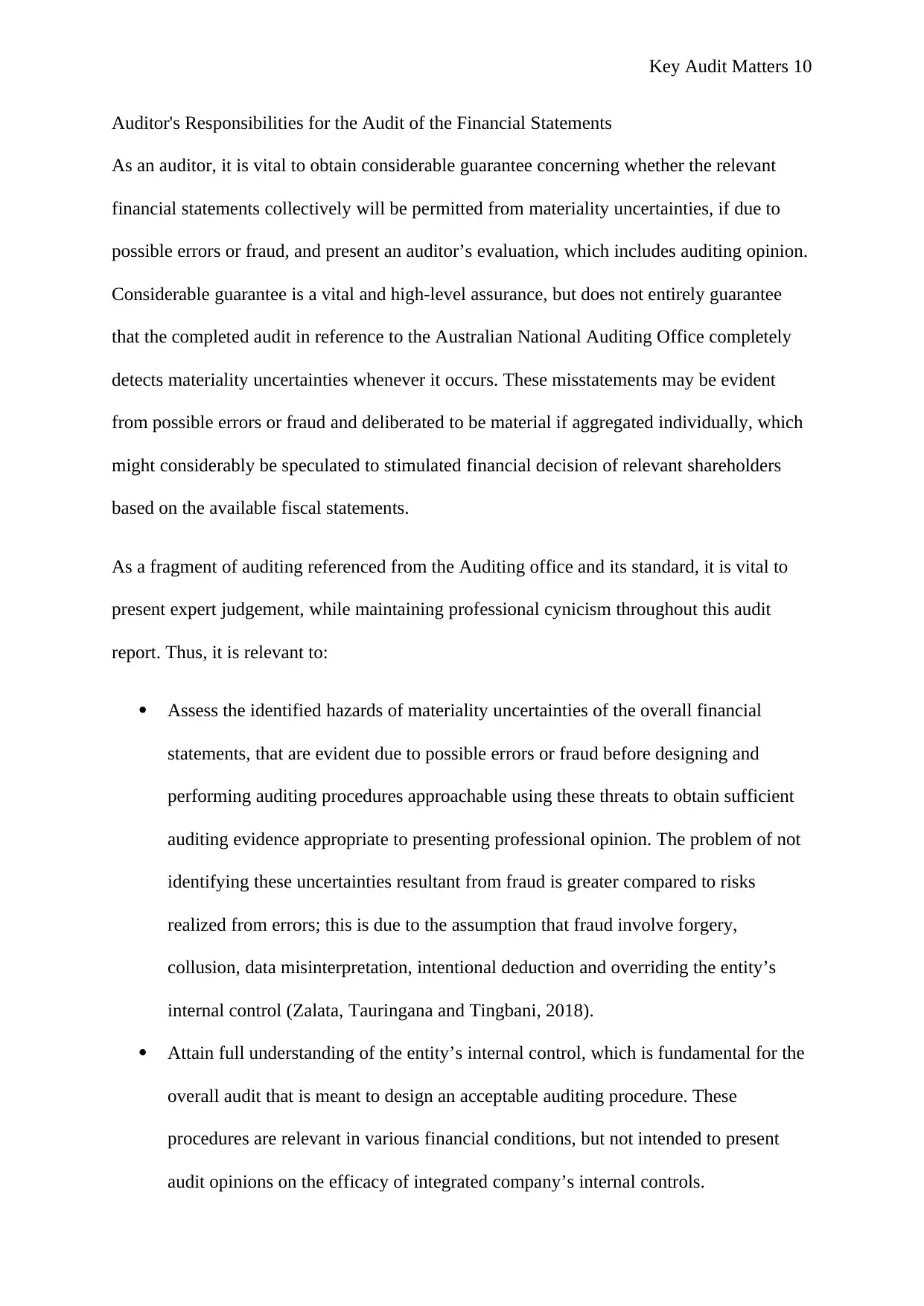
Key Audit Matters 10
Auditor's Responsibilities for the Audit of the Financial Statements
As an auditor, it is vital to obtain considerable guarantee concerning whether the relevant
financial statements collectively will be permitted from materiality uncertainties, if due to
possible errors or fraud, and present an auditor’s evaluation, which includes auditing opinion.
Considerable guarantee is a vital and high-level assurance, but does not entirely guarantee
that the completed audit in reference to the Australian National Auditing Office completely
detects materiality uncertainties whenever it occurs. These misstatements may be evident
from possible errors or fraud and deliberated to be material if aggregated individually, which
might considerably be speculated to stimulated financial decision of relevant shareholders
based on the available fiscal statements.
As a fragment of auditing referenced from the Auditing office and its standard, it is vital to
present expert judgement, while maintaining professional cynicism throughout this audit
report. Thus, it is relevant to:
Assess the identified hazards of materiality uncertainties of the overall financial
statements, that are evident due to possible errors or fraud before designing and
performing auditing procedures approachable using these threats to obtain sufficient
auditing evidence appropriate to presenting professional opinion. The problem of not
identifying these uncertainties resultant from fraud is greater compared to risks
realized from errors; this is due to the assumption that fraud involve forgery,
collusion, data misinterpretation, intentional deduction and overriding the entity’s
internal control (Zalata, Tauringana and Tingbani, 2018).
Attain full understanding of the entity’s internal control, which is fundamental for the
overall audit that is meant to design an acceptable auditing procedure. These
procedures are relevant in various financial conditions, but not intended to present
audit opinions on the efficacy of integrated company’s internal controls.
Auditor's Responsibilities for the Audit of the Financial Statements
As an auditor, it is vital to obtain considerable guarantee concerning whether the relevant
financial statements collectively will be permitted from materiality uncertainties, if due to
possible errors or fraud, and present an auditor’s evaluation, which includes auditing opinion.
Considerable guarantee is a vital and high-level assurance, but does not entirely guarantee
that the completed audit in reference to the Australian National Auditing Office completely
detects materiality uncertainties whenever it occurs. These misstatements may be evident
from possible errors or fraud and deliberated to be material if aggregated individually, which
might considerably be speculated to stimulated financial decision of relevant shareholders
based on the available fiscal statements.
As a fragment of auditing referenced from the Auditing office and its standard, it is vital to
present expert judgement, while maintaining professional cynicism throughout this audit
report. Thus, it is relevant to:
Assess the identified hazards of materiality uncertainties of the overall financial
statements, that are evident due to possible errors or fraud before designing and
performing auditing procedures approachable using these threats to obtain sufficient
auditing evidence appropriate to presenting professional opinion. The problem of not
identifying these uncertainties resultant from fraud is greater compared to risks
realized from errors; this is due to the assumption that fraud involve forgery,
collusion, data misinterpretation, intentional deduction and overriding the entity’s
internal control (Zalata, Tauringana and Tingbani, 2018).
Attain full understanding of the entity’s internal control, which is fundamental for the
overall audit that is meant to design an acceptable auditing procedure. These
procedures are relevant in various financial conditions, but not intended to present
audit opinions on the efficacy of integrated company’s internal controls.
Paraphrase This Document
Need a fresh take? Get an instant paraphrase of this document with our AI Paraphraser
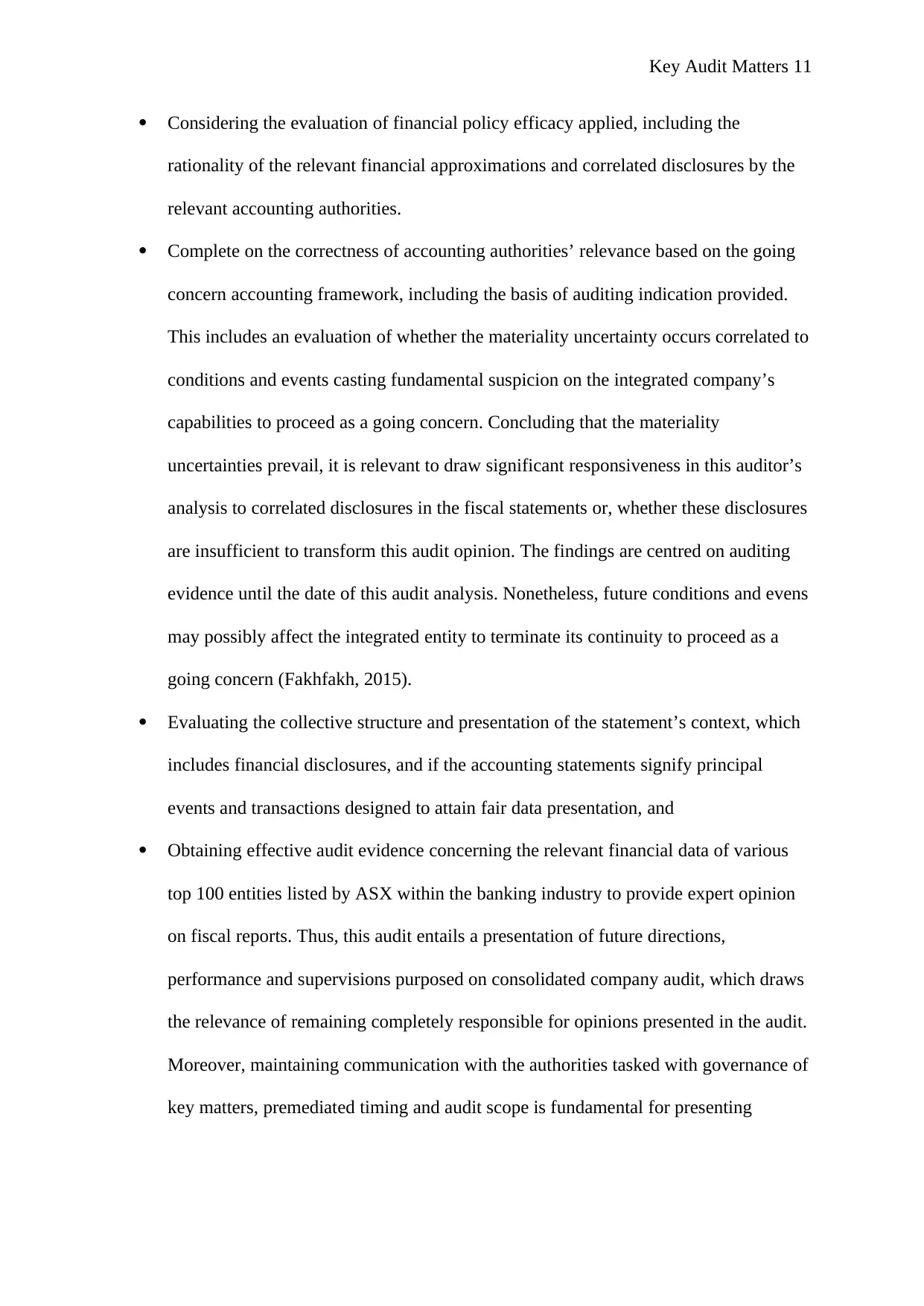
Key Audit Matters 11
Considering the evaluation of financial policy efficacy applied, including the
rationality of the relevant financial approximations and correlated disclosures by the
relevant accounting authorities.
Complete on the correctness of accounting authorities’ relevance based on the going
concern accounting framework, including the basis of auditing indication provided.
This includes an evaluation of whether the materiality uncertainty occurs correlated to
conditions and events casting fundamental suspicion on the integrated company’s
capabilities to proceed as a going concern. Concluding that the materiality
uncertainties prevail, it is relevant to draw significant responsiveness in this auditor’s
analysis to correlated disclosures in the fiscal statements or, whether these disclosures
are insufficient to transform this audit opinion. The findings are centred on auditing
evidence until the date of this audit analysis. Nonetheless, future conditions and evens
may possibly affect the integrated entity to terminate its continuity to proceed as a
going concern (Fakhfakh, 2015).
Evaluating the collective structure and presentation of the statement’s context, which
includes financial disclosures, and if the accounting statements signify principal
events and transactions designed to attain fair data presentation, and
Obtaining effective audit evidence concerning the relevant financial data of various
top 100 entities listed by ASX within the banking industry to provide expert opinion
on fiscal reports. Thus, this audit entails a presentation of future directions,
performance and supervisions purposed on consolidated company audit, which draws
the relevance of remaining completely responsible for opinions presented in the audit.
Moreover, maintaining communication with the authorities tasked with governance of
key matters, premediated timing and audit scope is fundamental for presenting
Considering the evaluation of financial policy efficacy applied, including the
rationality of the relevant financial approximations and correlated disclosures by the
relevant accounting authorities.
Complete on the correctness of accounting authorities’ relevance based on the going
concern accounting framework, including the basis of auditing indication provided.
This includes an evaluation of whether the materiality uncertainty occurs correlated to
conditions and events casting fundamental suspicion on the integrated company’s
capabilities to proceed as a going concern. Concluding that the materiality
uncertainties prevail, it is relevant to draw significant responsiveness in this auditor’s
analysis to correlated disclosures in the fiscal statements or, whether these disclosures
are insufficient to transform this audit opinion. The findings are centred on auditing
evidence until the date of this audit analysis. Nonetheless, future conditions and evens
may possibly affect the integrated entity to terminate its continuity to proceed as a
going concern (Fakhfakh, 2015).
Evaluating the collective structure and presentation of the statement’s context, which
includes financial disclosures, and if the accounting statements signify principal
events and transactions designed to attain fair data presentation, and
Obtaining effective audit evidence concerning the relevant financial data of various
top 100 entities listed by ASX within the banking industry to provide expert opinion
on fiscal reports. Thus, this audit entails a presentation of future directions,
performance and supervisions purposed on consolidated company audit, which draws
the relevance of remaining completely responsible for opinions presented in the audit.
Moreover, maintaining communication with the authorities tasked with governance of
key matters, premediated timing and audit scope is fundamental for presenting
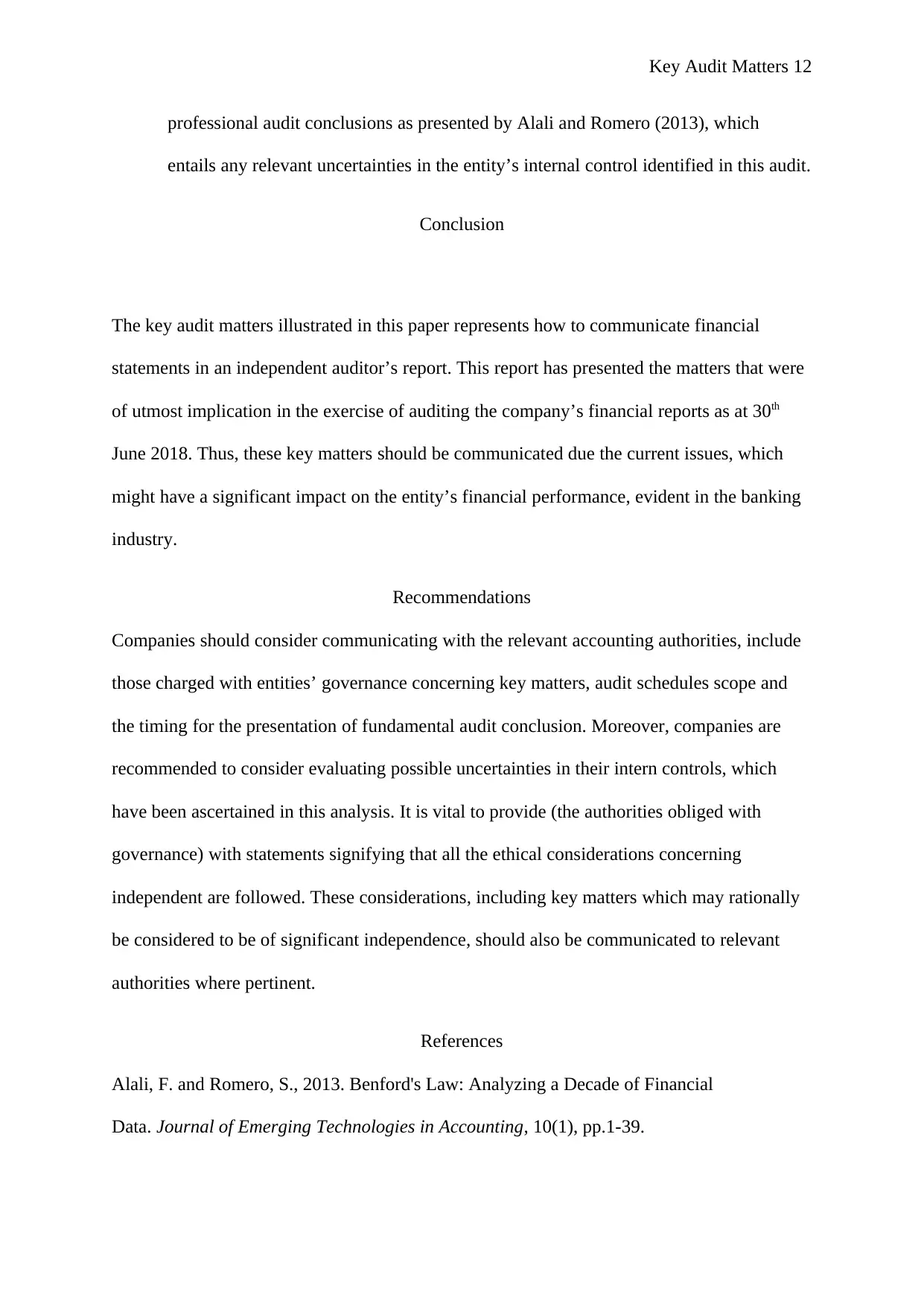
Key Audit Matters 12
professional audit conclusions as presented by Alali and Romero (2013), which
entails any relevant uncertainties in the entity’s internal control identified in this audit.
Conclusion
The key audit matters illustrated in this paper represents how to communicate financial
statements in an independent auditor’s report. This report has presented the matters that were
of utmost implication in the exercise of auditing the company’s financial reports as at 30th
June 2018. Thus, these key matters should be communicated due the current issues, which
might have a significant impact on the entity’s financial performance, evident in the banking
industry.
Recommendations
Companies should consider communicating with the relevant accounting authorities, include
those charged with entities’ governance concerning key matters, audit schedules scope and
the timing for the presentation of fundamental audit conclusion. Moreover, companies are
recommended to consider evaluating possible uncertainties in their intern controls, which
have been ascertained in this analysis. It is vital to provide (the authorities obliged with
governance) with statements signifying that all the ethical considerations concerning
independent are followed. These considerations, including key matters which may rationally
be considered to be of significant independence, should also be communicated to relevant
authorities where pertinent.
References
Alali, F. and Romero, S., 2013. Benford's Law: Analyzing a Decade of Financial
Data. Journal of Emerging Technologies in Accounting, 10(1), pp.1-39.
professional audit conclusions as presented by Alali and Romero (2013), which
entails any relevant uncertainties in the entity’s internal control identified in this audit.
Conclusion
The key audit matters illustrated in this paper represents how to communicate financial
statements in an independent auditor’s report. This report has presented the matters that were
of utmost implication in the exercise of auditing the company’s financial reports as at 30th
June 2018. Thus, these key matters should be communicated due the current issues, which
might have a significant impact on the entity’s financial performance, evident in the banking
industry.
Recommendations
Companies should consider communicating with the relevant accounting authorities, include
those charged with entities’ governance concerning key matters, audit schedules scope and
the timing for the presentation of fundamental audit conclusion. Moreover, companies are
recommended to consider evaluating possible uncertainties in their intern controls, which
have been ascertained in this analysis. It is vital to provide (the authorities obliged with
governance) with statements signifying that all the ethical considerations concerning
independent are followed. These considerations, including key matters which may rationally
be considered to be of significant independence, should also be communicated to relevant
authorities where pertinent.
References
Alali, F. and Romero, S., 2013. Benford's Law: Analyzing a Decade of Financial
Data. Journal of Emerging Technologies in Accounting, 10(1), pp.1-39.
⊘ This is a preview!⊘
Do you want full access?
Subscribe today to unlock all pages.

Trusted by 1+ million students worldwide
1 out of 13
Related Documents
Your All-in-One AI-Powered Toolkit for Academic Success.
+13062052269
info@desklib.com
Available 24*7 on WhatsApp / Email
![[object Object]](/_next/static/media/star-bottom.7253800d.svg)
Unlock your academic potential
Copyright © 2020–2025 A2Z Services. All Rights Reserved. Developed and managed by ZUCOL.





